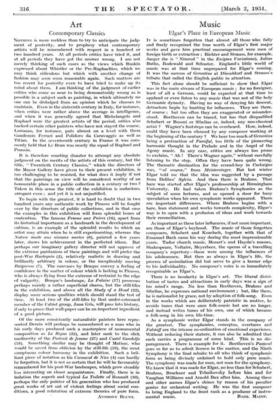Art
Contemporary Classics
NOTHING is more reckless than to try to anticipate the judg- ment of posterity, and to prophesy what contemporary artists will be remembered with respect in a hundred or two hundred years. At all periods critics have tried it, and at all periods they have got the answer wrong. I am not merely thinking of such cases as the views which Ruskin expressed about Whistler or the Pre-Raphaelites, which we may think ridiculous but which with another change of fashion may soon seem reasonable again. Such matters are too recent for posterity even to have tried to make up its mind about them. I am thinking of the judgment of earlier critics who come as near to being demonstrably wrong as is possible in a subject such as painting, in which ultimately no one can be dislodged from an opinion which he chooses to maintain. Even in the sixteenth century in Italy, for instance, when critics were rather above the average in intelligence, and when it was generally agreed that Michelangelo and Raphael were the greatest artists of the period, critics also hacked certain other painters who have not stayed the course. Lomazzo, for instance, puts almost on a level with them Gaudenzio Ferrari and Polidoro da Caravaggio as well as Titian. In the seventeenth century in France it was com- monly held that Le Brun was nearly the equal of Raphael and Poussin.
It is therefore courting disaster to attempt any absolute judgment on the merits of the artists of this century, but the title, " Twentieth Century Classics," which the directors of the Mayor Gallery have given to their present exhibition, is too challenging to be resisted, for what does it imply if not that the paintings on view will be considered worthy of an honourable place in a public collection in a century or two ? Taken in this sense the title of the exhibition is audacious, arrogant even ; and yet it is not unjustified.
To begin with the greatest, it is hard to doubt that in two hundred years any authentic work by Picasso will be fought over by the directors of public collections, and in that case the examples in this exhibition will form splendid bones of contention. The famous Femme aux Poises (16), apart from its historical importance as a landmark in the development of cubism, is an example of the splendid results to which an artist may attain when he is still experimenting, whereas the .Nature morte aux oiseaux mortes (8), painted a few years later, shows his achievement in the perfected idiom. But perhaps our imaginary gallery director will not approve of the extreme puritanism of these paintings and will prefer the post-War Harlequin (2), relatively realistic in drawing and brilliantly arbitrary in colour, or the inexplicably moving Baigneuse (7). The canvases by Braque convey a feeling of confidence in the matter of colour which is lacking in Picasso, who is always flying from the extreme of restraint to the edge of vulgarity. Braque's landscape, La Falaise (17) possesses perhaps mainly a rather superficial charm, but the still-lifes in the exhibition, and above all the Study of a Head (22), display more serious qualities which should stand the test of time. At least two of the still-lifes by that under-esteemed member of the Cubist group, Juan Gris, will pass into history, if only to prove that wall-paper can be an important ingredient of a good picture.
Of the more consistently naturalistic painters here repre- sented Derain will perhaps be remembered as a man who in his early days produced such a masterpiece of monumental composition as Le Repos (32), and later sank to the slick mediocrity of the Portrait de femme (27) and Castel Gandolfo (18). Something similar may be thought of Matisse, who would be saved from oblivion by the still-life (19), the most sumptuous colour harmony in the exhibition. Such a bril- liant piece of notation as his Carnaval de Nice (4) can hardly be forgotten, but it is not so certain that he will be favourably remembered for his post-War landscapes, which grow steadily less interesting on closer acquaintance. Finally, there is in isolation the superb and typical La Toilette of Rouault (10), perhaps the only painter of his generation who has produced great works of art out of violent feelings about social con- ditions, a good refutation of extreme theories of pure form.
ANTnoNY BLUNT.




























































 Previous page
Previous page